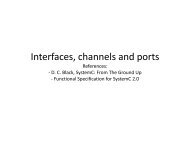An Overview of the PKCS Standards
An Overview of the PKCS Standards
An Overview of the PKCS Standards
You also want an ePaper? Increase the reach of your titles
YUMPU automatically turns print PDFs into web optimized ePapers that Google loves.
Page 14<br />
ERROR! STYLE NOT DEFINED.<br />
5.1.2 Fur<strong>the</strong>r compatibilities<br />
RSA encryption in <strong>PKCS</strong> #1, in block types 01 and 02, is <strong>the</strong> same as in PEM, as defined<br />
RFC 1423.<br />
Certificates in PEM are one <strong>of</strong> <strong>the</strong> alternatives <strong>of</strong> <strong>PKCS</strong> #7's<br />
ExtendedCertificateOrCertificate type. (See <strong>the</strong> next section for more<br />
details.) The md2WithRSAEncryption and md5WithRSAEncryption signature<br />
algorithms in <strong>PKCS</strong> #1 are <strong>the</strong> same as PEM's message and certificate signature<br />
algorithms.<br />
Certificate revocation lists (CRLs) in PEM are in <strong>PKCS</strong> #7's<br />
CertificateRevocationLists type.<br />
5.2 Directory Services— Au<strong>the</strong>ntication Framework (X.509)<br />
<strong>PKCS</strong> is compatible with Directory Services— Au<strong>the</strong>ntication Framework, as defined in<br />
CCITT Recommendation X.509.<br />
5.2.1 Primary compatibilities<br />
A certificate generated according to X.509 can be converted to a form that can be used in<br />
implementations <strong>of</strong> <strong>PKCS</strong> #7. The conversion involves <strong>the</strong> type<br />
ExtendedCertificateOrCertificate, which has two alternatives, an X.509<br />
certificate and a <strong>PKCS</strong> #6 extended certificate.<br />
<strong>An</strong> extended certificate generated according to <strong>PKCS</strong> #6 can be converted to a form that<br />
can be used in implementations <strong>of</strong> X.509, since an extended certificate contains an X.509<br />
certificate. The conversion involves <strong>the</strong> omission <strong>of</strong> extended attributes.<br />
5.2.2 Fur<strong>the</strong>r compatibilities<br />
RSA private-key encryption in <strong>PKCS</strong> #1 is <strong>the</strong> same, in block type 00, as RSA privatekey<br />
encryption in X.509.<br />
The signature process for X.509 certificates is <strong>the</strong> same as <strong>the</strong> signature process for <strong>PKCS</strong><br />
#6 extended certificates. That is, both use X.509's SIGNED macro (or an equivalent<br />
form), so both can use any signature algorithm consistent with <strong>the</strong> SIGNED macro.<br />
The md2WithRSAEncryption and md5WithRSAEncryption signature<br />
algorithms in <strong>PKCS</strong> #1 are consistent with <strong>the</strong> SIGNED macro, in that <strong>the</strong>y input an octet<br />
string and output a bit string. Thus, <strong>the</strong>y can be used in signing X.509 certificates, or any<br />
o<strong>the</strong>r quantity signed in <strong>the</strong> au<strong>the</strong>ntication framework or in o<strong>the</strong>r uses <strong>of</strong> <strong>the</strong> SIGNED<br />
macro (e.g., in X.411 security— see Section 5.3.2).

















